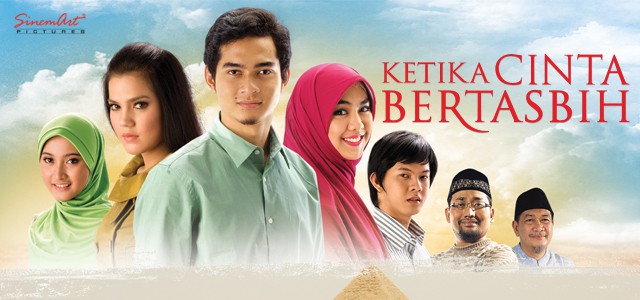While watching the wedding scene between Fahry and Aisha in the Ayat-Ayat Cinta (AAC, 2008), this self muttered to herself, “How come, the marriage is more like an Indian movie, huh? Is it because the producer is of Indian descent? ” Maybe yes, maybe no. To be sure, at AAC, Kang Abik, greeting author Habiburrahman El-Shirazy, is not too intensely involved in the film version of his best-seller novel. So what is then seen in the film version is different from the novel. The film version, for example, is made more melodramatic. Not only served the audience in the novel but the film, yes it was, was more like an “Indian film” minus singing and dance than an Islamic film. Not to mention the producers who want to play thrifty, change the place of shooting in Egypt according to the original story to India.
Nonetheless, AAC remains successfully watched by millions of people. This is partly because the readers of his novels who want to see their favorite “chick lit sisters” are filmed; most others, however, because they like the melodramatic cultivation of Hanung Bramantyo, the director. Although there was a bonus, after the film was a success, in my heart, I think there was something to block. AAC film version, more or less, betrayed the novel.
So, when there is an offer from another producer who is aiming for his other novel, Kang Abik sets his horses. Surely he proposed this and that condition when the book was filmed. Well, the producer who might have green eyes seeing money in front of his eyes (because he thought the film would be successful, whatever the outcome) would have just agreed. All the conditions for Kang Abik must be fulfilled. Like a word, ask for the earth and sky to be given.
Precisely here, the problem begins. Kang Abik was involved as a supervisor. The supervisor here is tasked not only with monitoring from a distance. But this opinion was also asked for, and even — it might be — asked for a signature of the agreement. So, Chaerul Umam, who made the Islamic film Titian Serambut in Belah Tujuh and Imam Tantowi, who is a seasoned screenwriter, is no more than a handyman. Messengers. Where is the producer, who has the money? Oh, he doesn’t seem to mind this much. He was instead busy making hype so that this film was already in the minds of people long before it aired. The trick is also tacky: making the casting process of a debutant cast in a reality show model AFI, KDI, or the like – which then leads to another problem when the film is finished because most of these debutants act rigidly.
As a result, the film is faithful to the novel. Actual scene by scene like picked out from the book. It doesn’t matter if the scene is essential or not. It doesn’t matter if the scene is too literary.
Yes, this film, Ketika Cinta Bertasbih (2009), does not have an accurate visual language. AAC, which is outrageous Indian in some scenes (which means here the visual language works), still makes it touched (remember the scene when Fachry married Maria or when Fachry prayed with Maria). But this one, the touching scene is precisely when the character reads a letter full of emotion from his village in Indonesia. Highlighting the scene of reading a letter is enough to take a close-up picture of the character and be given a voice over the contents of the letter from the sender. That is to say, again, what made the emotion was not the scene. But the letter. Literary language. Not the visual style.
I believe the film is judged precisely by its visual language because the film depends on the motion of images and scenes, while literature is judged by the choice of the words of the author. When the film is more talkative, the film is talking a lot.
Da’wah, in this film, is also very verbal. Hadiths, verses, or opinions of scholars are often quoted in full while referring to the page in question. When a character takes the books that become his references when submitting these conditions, when they are invited, I am afraid that he will read them starting from the introduction (fortunately not). This film is like a sermon delivered by the mouths of the characters.
The late Asrul Sani, who was a genius filmmaker, once said that sermon was the easiest. That is, filmmakers of this film just looking easy. They do not think too hard to make the language of images containing da’wah subtly, not verbally, and full of sermons. Even though it is subtle and not felt, that is more striking. After watching this film, I swear I do not remember the names of the books or narrators of the hadith, which became a legal reference for such.
From here, I then remembered Laskar Pelangi (2008), the mega box office movie, which also departed from the best-selling novel. The writer, Andrea Hirata, is said to humbly surrender completely to filmmakers (Riri Riza [director], Mira Lesmana [producer], and Salman Aristo [scenario]) to make the film.
Although he has full rights to the story, he realizes that he is not a filmmaker but a novelist. He is aware, novels and films can be different because they are different mediums and speak different languages. The result, the film version improved what Andrea had written so well. The film version is a work that is almost separated from the novel but with equally good results. Lovers of the book do not feel betrayed even though there are parts of the story that are missing. Because after all, they were treated to a beautiful spectacle.
Different from this one. Film viewers were even defeated. Kang Abik is the winner. If you follow the tradition of releasing DVDs in Hollywood there, it is better to wait for the “Director’s Cut” version of this film. Who knows different from this one, the “Writer’s Cut” version.
WATCH TRAILER







